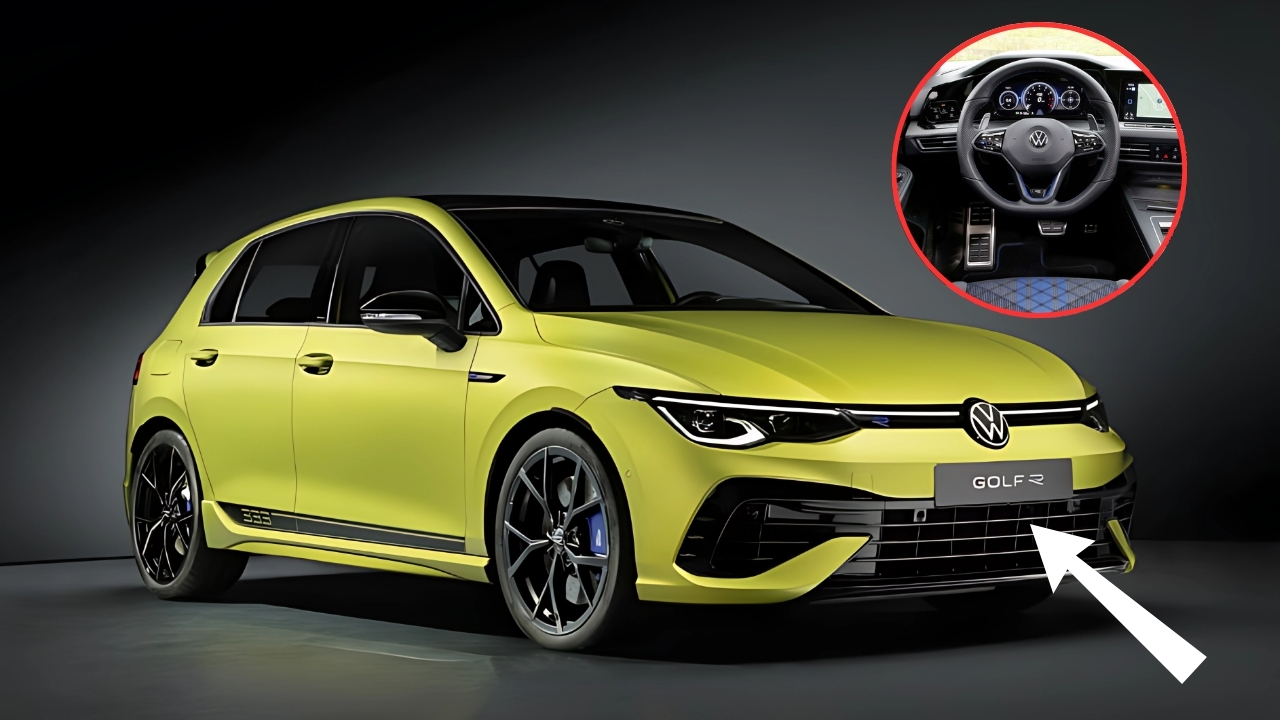Volkswagen Golf R : The automotive world has been abuzz with anticipation for what could become Volkswagen’s most potent hot hatch ever conceived – the rumored Golf R Clubsport.
However, recent revelations from company executives paint a picture of uncertainty and extended delays that may ultimately determine whether this performance machine ever sees the light of day.
The Vision Behind the Ultimate Golf
Understanding the significance of the potential Golf R Clubsport requires appreciating what Volkswagen has already accomplished with its Golf lineup.
The German automaker has systematically built one of the most comprehensive hot hatch families in the industry, ranging from the accessible yet spirited GTI to the all-weather capable Golf R.
Each model serves a distinct purpose in the performance hierarchy, yet enthusiasts have long wondered: what would happen if Volkswagen threw caution to the wind and created the ultimate expression of Golf performance?
Martin Hube, a global spokesperson for Volkswagen, provided tantalizing insights during interviews at the prestigious 24 Hours of Nürburgring event.
His comments revealed that engineers within the company have been actively developing what he described as a “more track-oriented version” of the Golf R, potentially bearing the coveted Clubsport designation that has become synonymous with Volkswagen’s most focused performance offerings.
The concept represents more than just another trim level – it embodies Volkswagen’s commitment to pushing the boundaries of what a front-wheel-drive platform can achieve when enhanced with intelligent all-wheel-drive technology and relentless engineering refinement.
The Golf R Clubsport would theoretically combine the proven EA888 turbocharged four-cylinder engine with additional performance modifications, weight reduction measures, and suspension geometry optimizations that could establish new benchmarks in the hot hatch segment.
Engineering Challenges and Performance Targets
Developing a vehicle that can meaningfully distinguish itself from the already impressive Golf R presents significant engineering challenges. The standard Golf R, with its 328 horsepower output and sophisticated 4Motion all-wheel-drive system, already occupies rarefied air in the performance compact segment.
Creating a Clubsport variant requires identifying areas where further enhancement can deliver tangible benefits without compromising the fundamental characteristics that make the Golf R appealing to a broad range of enthusiasts.
Volkswagen’s approach to previous Clubsport models provides valuable insights into their development philosophy. The Golf GTI Clubsport S, for instance, achieved remarkable success by securing the front-wheel-drive lap record at the Nürburgring with a blistering time of 7:49.
This accomplishment demonstrated Volkswagen’s ability to extract extraordinary performance from their platform when given the freedom to prioritize track capability over everyday compromises.
The potential Golf R Clubsport would likely follow a similar development trajectory, focusing on three primary areas of enhancement. First, engine modifications could extract additional power from the already potent EA888 unit through revised turbocharger mapping, enhanced cooling systems, and optimized exhaust routing.
While specific power figures remain speculative, industry observers suggest that achieving 350-370 horsepower would position the vehicle competitively against rivals from Mercedes-AMG and Audi Sport.
Second, weight reduction measures would play a crucial role in improving power-to-weight ratios and enhancing dynamic responsiveness. This could involve the strategic use of carbon fiber components, deletion of certain comfort features, and the implementation of lightweight alternatives for traditional materials.
The Golf GTI Clubsport already demonstrates this approach through its optional Euro Style package, which removes the sunroof and substitutes manual cloth seats for power leather units, resulting in meaningful weight savings.
Third, suspension and chassis modifications would optimize the vehicle for track use while maintaining sufficient compliance for road driving.
This balance represents one of the most challenging aspects of developing a successful Clubsport variant, as engineers must preserve the Golf R’s renowned everyday usability while delivering the precision and responsiveness demanded by serious driving enthusiasts.
Market Dynamics and Financial Considerations
The extended delay facing the Golf R Clubsport reflects broader challenges confronting the automotive industry, particularly regarding the viability of low-volume, high-performance variants in an increasingly crossover-dominated marketplace.
Volkswagen’s board members face the unenviable task of justifying significant development investments for vehicles that, while emotionally compelling, represent relatively small portions of overall sales volumes.
Contemporary market analysis reveals that hot hatches occupy an increasingly niche position in consumer preferences. The shift toward SUVs and crossovers has fundamentally altered purchasing patterns, with many traditional hot hatch buyers gravitating toward performance-oriented crossovers that offer similar excitement with enhanced practicality.
This trend forces manufacturers to carefully evaluate whether investing millions of dollars in specialized variants can generate sufficient returns to justify their development.
Volkswagen’s situation is further complicated by the substantial costs associated with emissions compliance and electrification initiatives. Regulatory pressures across global markets demand significant investment in hybrid and electric powertrains, potentially reducing available resources for internal combustion engine projects like the Golf R Clubsport.
The company must balance enthusiast desires with regulatory requirements and shareholder expectations, creating a complex decision-making environment.
The financial equation becomes even more challenging when considering the limited production volumes typical of Clubsport variants. Unlike mainstream models that benefit from economies of scale, specialized performance vehicles require dedicated development resources while serving relatively small customer bases.
This dynamic necessitates premium pricing strategies that can further limit market appeal, creating a cyclical challenge that complicates business case development.
Global Market Considerations and Regional Variations
The potential Golf R Clubsport faces additional complexity due to varying market conditions across different regions. European markets, with their strong hot hatch traditions and extensive track day cultures, represent the most natural fit for such a specialized vehicle. However, these markets also face increasingly stringent emissions regulations that could complicate the certification process for high-performance variants.
North American markets present a different set of challenges and opportunities. While the United States has historically shown strong enthusiasm for performance-oriented Volkswagen models, the company’s reduced product portfolio in the region limits the Golf lineup to just the GTI and Golf R variants. The absence of the Golf GTI Clubsport in American showrooms already demonstrates Volkswagen’s cautious approach to introducing specialized variants in markets where their viability remains questionable.
Asian markets, particularly those with developing track day scenes and growing enthusiasm for European performance cars, could represent untapped potential for the Golf R Clubsport. However, varying safety and emissions standards across these regions would require additional certification efforts that further complicate the business case.
The regional variation in market conditions forces Volkswagen to consider whether developing a vehicle primarily for European consumption can generate sufficient volumes to justify its existence. This consideration becomes particularly relevant when evaluating the costs associated with adapting the vehicle for different regulatory environments and consumer preferences.
Competitive Landscape and Industry Context
The delayed decision regarding the Golf R Clubsport occurs within a rapidly evolving competitive landscape that has seen several traditional rivals exit the hot hatch segment entirely. The discontinuation of models like the Ford Focus RS has reduced direct competition while simultaneously demonstrating the challenges facing specialized performance vehicles in contemporary markets.
Remaining competitors, including the Honda Civic Type R and emerging electric performance variants from various manufacturers, represent both threats and opportunities for Volkswagen. The Type R’s continued success demonstrates that demand exists for uncompromising performance vehicles, while the emergence of electric alternatives suggests that future Clubsport variants might need to incorporate electrification to remain relevant.
Mercedes-AMG and Audi Sport continue developing high-performance compact vehicles, creating competitive pressure that could influence Volkswagen’s decision-making process. The success of models like the Mercedes-AMG A45 S and Audi RS3 demonstrates that consumers remain willing to pay premium prices for exceptional performance, provided the vehicles deliver commensurate capabilities.
The competitive landscape also includes emerging manufacturers and specialized tuning companies that offer enhanced versions of existing vehicles. These alternatives could potentially satisfy some demand for ultimate Golf performance, reducing the market opportunity for an official Volkswagen offering.
Technological Evolution and Future Considerations
The extended delay facing the Golf R Clubsport coincides with rapid technological evolution that could fundamentally alter the vehicle’s specification and market positioning. Advances in electrification technology, particularly regarding hybrid systems optimized for performance applications, might influence the final powertrain configuration if the project ultimately receives approval.
Volkswagen’s commitment to electrification across its portfolio suggests that any future Clubsport variant might incorporate hybrid assistance to achieve performance targets while meeting emissions requirements. This integration could provide opportunities for enhanced torque delivery and improved efficiency, though it would also add complexity and weight that could compromise the focused character that defines Clubsport models.
Advanced driver assistance systems and connectivity features represent another area where technological evolution could influence the project’s scope and timeline. Balancing the integration of contemporary safety and convenience technologies with the stripped-down ethos typical of track-focused variants presents ongoing challenges that could extend development timelines.
The potential integration of advanced aerodynamic systems, including active elements that optimize performance for different driving conditions, represents another technological consideration that could enhance the vehicle’s capability while adding complexity to the development process.
Industry Implications and Broader Significance
The fate of the Golf R Clubsport extends beyond Volkswagen’s product portfolio to represent broader industry trends regarding the future of internal combustion performance vehicles. The decision-making process illuminates the challenges facing automakers as they navigate the transition toward electrification while attempting to satisfy enthusiast communities that remain passionate about traditional performance cars.
The extended delay reflects the automotive industry’s broader struggle to balance short-term financial pressures with long-term brand building and customer loyalty considerations. Performance variants like the potential Golf R Clubsport serve important roles in maintaining brand credibility and engineering expertise, even when their direct financial contributions remain modest.
The outcome of Volkswagen’s deliberations could influence other manufacturers’ approaches to similar projects, potentially affecting the broader availability of specialized performance vehicles across the industry. A positive decision could encourage other brands to pursue their own ultimate variants, while cancellation might signal a broader retreat from such projects.
The Path Forward
As Volkswagen’s board continues deliberating the Golf R Clubsport’s fate, several factors will likely influence their ultimate decision. Market research regarding consumer demand, competitive analysis of similar vehicles’ success, and detailed financial projections will all play crucial roles in determining whether the project advances to production.
The company’s commitment to maintaining its performance vehicle heritage, particularly given the Golf’s 50-year history and the R designation’s significance within Volkswagen’s lineup, provides reasons for optimism among enthusiasts. However, the practical realities of contemporary automotive business, including regulatory compliance costs and market dynamics, present substantial obstacles that cannot be ignored.
Regardless of the final outcome, the extended delay facing the Golf R Clubsport illustrates the complex challenges confronting automotive manufacturers in an era of rapid technological and regulatory change. The project’s fate will ultimately depend on Volkswagen’s willingness to invest in emotional appeal and brand heritage versus purely financial considerations, a decision that will resonate far beyond the hot hatch segment.
The automotive enthusiast community continues watching these developments with keen interest, understanding that the decision regarding the Golf R Clubsport could significantly influence the future landscape of performance vehicles. Whether this ultimate expression of Golf performance ever reaches production will depend on factors extending far beyond pure engineering capability, encompassing market dynamics, regulatory requirements, and corporate strategy in ways that highlight the evolving nature of automotive development in the 21st century.

